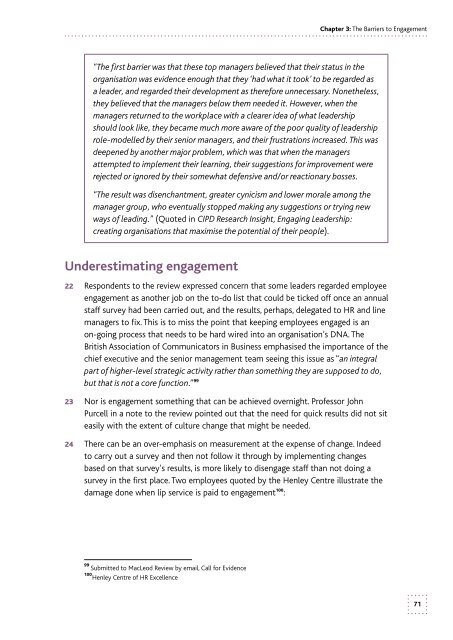3ytgeaf
3ytgeaf
3ytgeaf
Create successful ePaper yourself
Turn your PDF publications into a flip-book with our unique Google optimized e-Paper software.
Chapter 3: The Barriers to Engagement<br />
“The first barrier was that these top managers believed that their status in the<br />
organisation was evidence enough that they ‘had what it took’ to be regarded as<br />
a leader, and regarded their development as therefore unnecessary. Nonetheless,<br />
they believed that the managers below them needed it. However, when the<br />
managers returned to the workplace with a clearer idea of what leadership<br />
should look like, they became much more aware of the poor quality of leadership<br />
role-modelled by their senior managers, and their frustrations increased. This was<br />
deepened by another major problem, which was that when the managers<br />
attempted to implement their learning, their suggestions for improvement were<br />
rejected or ignored by their somewhat defensive and/or reactionary bosses.<br />
“The result was disenchantment, greater cynicism and lower morale among the<br />
manager group, who eventually stopped making any suggestions or trying new<br />
ways of leading.” (Quoted in CIPD Research Insight, Engaging Leadership:<br />
creating organisations that maximise the potential of their people).<br />
Underestimating engagement<br />
22 Respondents to the review expressed concern that some leaders regarded employee<br />
engagement as another job on the to-do list that could be ticked off once an annual<br />
staff survey had been carried out, and the results, perhaps, delegated to HR and line<br />
managers to fix. This is to miss the point that keeping employees engaged is an<br />
on-going process that needs to be hard wired into an organisation’s DNA. The<br />
British Association of Communicators in Business emphasised the importance of the<br />
chief executive and the senior management team seeing this issue as “an integral<br />
part of higher-level strategic activity rather than something they are supposed to do,<br />
but that is not a core function.” 99<br />
23 Nor is engagement something that can be achieved overnight. Professor John<br />
Purcell in a note to the review pointed out that the need for quick results did not sit<br />
easily with the extent of culture change that might be needed.<br />
24 There can be an over-emphasis on measurement at the expense of change. Indeed<br />
to carry out a survey and then not follow it through by implementing changes<br />
based on that survey’s results, is more likely to disengage staff than not doing a<br />
survey in the first place. Two employees quoted by the Henley Centre illustrate the<br />
damage done when lip service is paid to engagement 100 :<br />
99<br />
Submitted to MacLeod Review by email, Call for Evidence<br />
100<br />
Henley Centre of HR Excellence<br />
71


